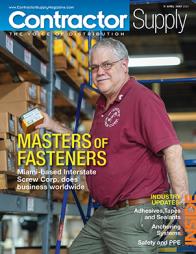Jason Bader: Know Your Place!
The Distributor’s place in — and value to — the supply chain.
It seems that everywhere I turn, someone is trying to cut out the middleman. Who is this middleman and why do I want to get rid of him? In the circles in which I walk, the distribution link in the supply chain is often viewed as this part everyone is looking to cut out. I fear that this axe wielding view of the role distribution plays is due to a bad public relations campaign.
Moreover, the distributor is willingly serving their head on a block when they fail to recognize and publicize their contribution to the chain. If distributors want to remain viable, they must be able to clearly articulate their value proposition.
When I teach distribution management, I often open with a brief discussion of the supply chain. In most industries, the distributor resides between the manufacturer and another reseller of the goods they distribute. Some sell down the chain to dealers, others sell to hard goods manufacturers, and still others sell to installation professionals. I generally pose the question, “Why doesn’t the manufacturer sell directly to the customer of the distributor?” Wouldn’t it be more efficient? This goes to the heart of the middleman-severing philosophy.
Playing the devil’s advocate, I remind them that the gross profit margins they enjoy produce an additional cost in the supply chain. So what does a distributor do to justify this additional expense? This is where the rubber meets the road. When a distributor fails to provide value, he is no longer entitled to remove margin dollars from the chain.
Not only should a distributor provide value, but he can no longer keep it a secret. It is not good enough to sell value down the chain to the customer; but in order to duck the axe, distributors must also be able to sell up the chain to their suppliers.
Relationships
What do distributors really sell to their suppliers? Customer relationships. Several years ago, I was doing research on the relationship between suppliers and distributors in the floor covering industry. A soft goods manufacturer told me something that I will never forget: “He who controls the relationships in the market, controls the market.”
At the risk of throwing the flooring wholesalers under the bus, this is the lesson I learned from them. Many years ago, both the wholesalers and carpet mills had sales teams calling on floor covering dealers. Both teams would push the brand and the wholesaler would handle fulfillment. After some time, the wholesalers decided that both teams were a bit redundant and decided to let the carpet mill representatives call directly on their dealers.
For a period of time, this worked great. The orders flowed through the distributor as they always had, and the expense of a field sales team had been reduced. Can you guess what happened? Over time, the manufacturer/dealer relationship strengthened and the distributor/dealer relationship withered. Today, most major brands of carpet are sold dealer direct.
Trade Credit
One of the largest contributions distributors make to the supply chain comes in the willingness to extend trade credit to their customers. Do you think that the manufacturer would want to take on this burden? I think it might be a bigger pill than they could swallow.
The liberal credit policies employed by the distribution community acts as a lubricant to the supply chain. If credit was managed to the same rigidity as our banking partners, the chain would come to a grinding halt. While I am not saying that the extension of credit is managed perfectly by all members, the willingness to use it as a catalyst for sales is a value to all links in the chain.
Localized Inventory
By placing inventory closer the end-user, the chain benefits through speed and efficiency. Customers don’t have to tie up space and resources to buy in manufacturer minimums.
Distributors offer value by metering in product as needed. The customer doesn’t have to wait for transportation delays or lengthy order processing times. In several situations, customers can receive orders the same day. In many industries, speed means money. Reduction of down time is a very tangible benefit.
Breadth of Offering
By offering a wide variety of different products, a distributor can help customers write fewer purchase orders. This also caters to the reduction of down time. In many applications, labor is a far greater expense than the products consumed. When labor can remain working, overtime is reduced and the project comes in on budget. In some situations, early completion of a project can produce substantial rewards for the customer.
Product Knowledge Expertise
The downside of inventorying a breadth of products is the requirement for application-based training. Distributors go to great lengths to train their customer service and field personnel on the best product for the customer application. Sales teams can often point out labor saving advice for their customers.
In fact, the field sales profession has transformed from order writing to problem solving over the years. Given the fact that most distributors represent products from over 100 different suppliers, the need for training and education is greater than ever.
Warranty Support
Distributors stand behind the products they sell. They often go above and beyond to facilitate a warranty exchange with the manufacturer. They become advocates for the customer when disputes arise. Many of them will take care of the customers long after the manufacturer warranty period has expired. Since customer relationships are their currency, the distributor will often sacrifice short term profit for long term loyalty.
Bid Assistance
In several industries, wholesalers provide additional service to their customers by helping them plan for the consumable portion of the project. They do take-off work and create bid packages for contractors to help them win work. This involves an intimate understanding of what the customer does for a living.
Some distributors scour the drawings for opportunities to provide labor saving assemblies. It is very common for some construction-related distributors to provide fabrication work so that bids can become more competitive.
VMI and EDI
In the industrial markets, many distributors help their customers manage on-hand inventory levels. These vendor managed inventory (VMI) programs draw upon what distributors excel at — managing inventory — and allow the customer to concentrate on production.
Distribution has also been a key component in promoting transactional efficiency through electronic data interchange (EDI) protocols. These protocols allow the software programs of supply chain members to exchange and translate transactional documents.
The real reason I start out each course with an explanation of the supply chain is that I want distributors to never forget how they earn their money and why they invest so much in customer service. I want them explain their role in the supply chain to every member of the company — from delivery driver to credit manager.
Everyone in the organization must be able to internalize this value proposition and be certain that they are living up to the expectations promised.
Distributors take money out of the supply chain; and it is up to each one of us to remind others that we are worthy of it. CS
Jason Bader is managing partner of The Distribution Team, a firm that specializes in helping distributors become more profitable through operating efficiencies. The first 20 years of his career were spent working in distributor operations. Today, he is a regular speaker at industry events and spends much of his time working with individual distribution companies. For more information, call (503) 282-2333 or contact him by e-mail at Jason@Distributionteam.com. Also visit The Distribution Team’s Web site at www.thedistributionteam.com.
















